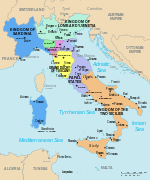
The Royal Order of Francis I was an extinct order of merit of the former Kingdom of the Two Sicilies which was annexed in 1861 by the King of Italy. It has been revived by Prince Carlo, Duke of Castro, as an award for services to charity and inter-religious understanding and includes a number of non-Roman Catholic statesmen and stateswomen among its membership.

Don Carlos María Alfonso Marcelo de Borbón-Dos Sicilias y Borbón-Parma, Infante of Spain, Duke of Calabria was, at his death, the last male infante of Spain during the reigns of his cousins King Juan Carlos I and King Felipe VI.

Prince Ferdinand Pius, Duke of Calabria and Castro, was head of the House of Bourbon-Two Sicilies and pretender to the throne of the extinct Kingdom of the Two Sicilies from 1934 to 1960.

The House of Bourbon-Two Sicilies is a cadet branch of the House of Bourbon that ruled Southern Italy and Sicily for more than a century in the 18th and 19th centuries. It descends from the Capetian dynasty in legitimate male line through Philip, Duke of Anjou, a younger grandson of Louis XIV of France (1638–1715) who established the Bourbon dynasty in Spain in 1700 as Philip V (1683–1746). In 1759, King Philip's younger grandson was appanaged with the kingdoms of Naples and Sicily, becoming Ferdinand IV and III (1751–1825), respectively, of those realms. His descendants occupied the joint throne, merged as the "Kingdom of the Two Sicilies" in 1816, until 1861, claimed it thereafter from exile, and constitute the extant Bourbon-Two Sicilies family.

Prince Ranieri Maria Gaetano, Duke of Castro was a claimant to the headship of the House of Bourbon-Two Sicilies.
Prince Ferdinand of Bourbon-Two Sicilies, Duke of Castro was a claimant to the headship of the former Royal House of the Two Sicilies.
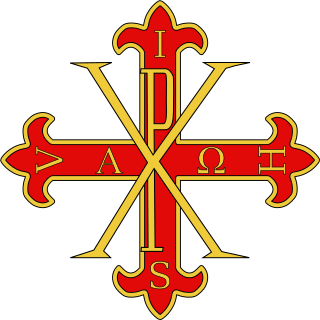
The Sacred Military Constantinian Order of Saint George, also historically referred to as the Imperial Constantinian Order of Saint George and the Order of the Constantinian Angelic Knights of Saint George, is a dynastic order of knighthood of the House of Bourbon-Two Sicilies. Currently, the grand magistry of the order is disputed among the two claimants to the headship of the formerly reigning House of Bourbon-Two Sicilies as heirs of the House of Farnese, namely Prince Pedro and Prince Carlo. The order was one of the rare orders confirmed as a religious-military order in the papal bull Militantis Ecclesiae in 1718, owing to a notable success in liberating Christians in the Peloponnese. Together with the Sovereign Military Order of Malta, it is one of a small number of Catholic orders that still have this status today. It is not an order of chivalry under the patronage of the Holy See, but its membership is restricted to practising Catholics.

Prince Carlo of Bourbon-Two Sicilies, Duke of Castro is one of the two claimants to the headship of the House of Bourbon-Two Sicilies.

The Order of Saint George of the Reunion is an order of knighthood of the Kingdom of the Two Sicilies. It was established to replace the Royal Order of the Two-Sicilies.
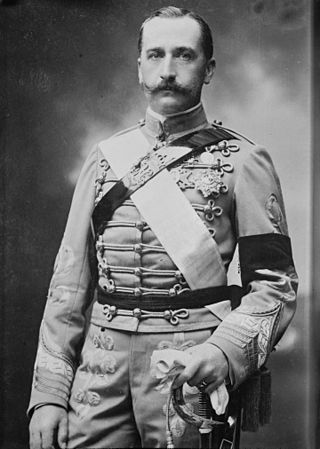
Don Carlos, Prince of Bourbon-Two Sicilies, Infante of Spain was the son of Prince Alfonso of the Two Sicilies, Count of Caserta and his wife Princess Maria Antonietta of Bourbon-Two Sicilies, and nephew of the last King of the Two Sicilies, Francis II.
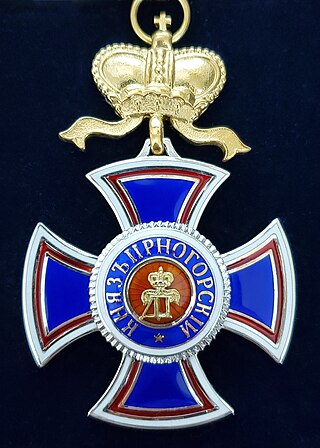
The Order of Prince Danilo I is an order, formerly of the Principality and later Kingdom, of Montenegro; it is currently a dynastic order granted by the head of the House of Petrović-Njegoš, Crown Prince Nicholas. It is awarded to prominent champions of the preservation of Montenegrin independence and for other humanitarian, scientific, artistic and pro-social achievements as defined by statute.

Domenico Pignatelli di Belmonte was an Italian Cardinal of the Roman Catholic Church.

Leopoldo Giovanni Giuseppe Michele of Bourbon-Two Sicilies, Prince of Salerno was a member of the House of Bourbon-Two Sicilies and a Prince of Bourbon-Two Sicilies. He married Archduchess Clementina of Austria in 1816, and became the Prince of Salerno.
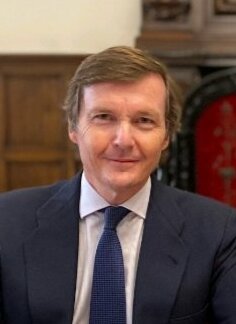
Prince Pedro of Bourbon-Two Sicilies, Duke of Calabria, Grandee of Spain, is the only son of Infante Carlos, Duke of Calabria (1938–2015), and his wife, Princess Anne of Orléans. As primogeniture heir of the kings of the Two Sicilies he is the principal claimant to the headship of the Royal House of Bourbon-Two Sicilies, which ruled the Kingdom of the Two Sicilies before the unification of Italy.

Prince Francis of the Two Sicilies, Count of Trapani was a member of the House of Bourbon-Two Sicilies.

Princess Béatrice Marie Caroline Louise Françoise of Bourbon-Two Sicilies is the eldest daughter of Prince Ferdinand, Duke of Castro, Castro-line claimant to the headship of the House of Bourbon-Two Sicilies, and his wife, Chantal de Chevron-Villette.

Prince Gabriele of Bourbon-Two Sicilies was a prince of the deposed dynasty which ruled the Kingdom of the Two Sicilies.

Marcantonio Colonna, 3rd Prince of Sonnino and 4th Marquess of Castelnuovo was an Italian nobleman, military and politician. He was Prince of Sonnino, Marquess of Castelnuovo, Grandee of Spain, and Knight of the Order of Saint Januarius. He became Viceroy of Sicily in 1775.
Don Francesco di Paola Mariano Luigi di Tocco Cantelmo Stuart, or Francesco di Tocco for short, was an 18th/19th-century Italian noble, serving as the Prince of Montemiletto and the titular Prince of Achaea from the death of his father Carlo II di Tocco Cantelmo Stuart in 1823 to his own death in 1877. Francesco was high-ranking among the nobility of the Kingdom of the Two Sicilies, serving as a governmental and military official, and was a knight of three different orders of knighthood.

Don Carlo III di Tocco Cantelmo Stuart, or Carlo di Tocco for short, was a 19th-century Italian noble, serving as the Prince of Montemiletto and the titular Prince of Achaea from the death of his father Francesco di Tocco Cantelmo Stuart in 1877 to his own death in 1884. Carlo III di Tocco Cantelmo Stuart was the last living member of the Tocco family, which had once ruled the Despotate of Epirus. Carlo was prominent among the nobility of Italy, having held high honors in the Kingdom of the Two Sicilies until its fall in 1861 and thereafter becoming a leader figure among those who sought to restore it.





















